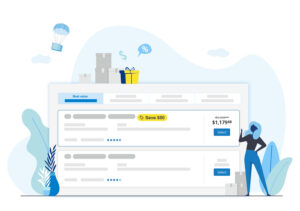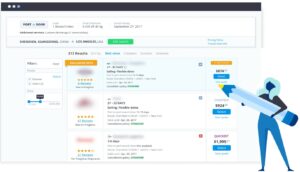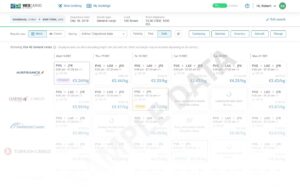How Rate Management Systems Support a Forwarder’s Business Flow
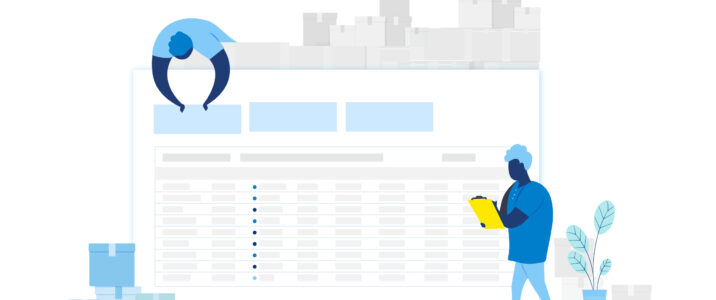
Welcome to Part II of WebCargo’s series on how and why Rate Management Systems [RMSs] have become a vital aspect of a freight forwarder’s tech stack…and how tech’s evolution is changing their role.
In this article, we’ll deep-dive into the top 10 benefits a comprehensive RMS provides, and how this helps forwarders efficiently manage the whirlpool of details needed to execute operations along increasingly sophisticated supply chains.
A Closer Look: The Top 10 Benefits of a Comprehensive RMS
Over the last few decades RMSs have taken leaps in the level of support they provide forwarders to manage the myriad of pricing and routing details that move global freight. Global freight is deeply dependent on connectivity between parties from start to finish. RMSs that bridge those gaps are therefore transformative when information can be shared end-to-end digitally and automatically.
The hypergrowth of carrier digitization has exponentially raised the bar required to win business. RMSs have therefore evolved to empower forwarders and their customers with real-time data and better communication. A comprehensive RMS will therefore provide multimodal rate management and quoting tools that include dynamic, real-time rates and access to actual capacity to shorten the quoting process and facilitate eBookings, providing forwarders with increased transparency, speed, and efficiency across the entire value chain.
This means not only increased revenue for forwarders and carriers, but also improved service and satisfaction for their shippers.
- Ensures that rates sent from carriers to forwarders are easily accessible and comparable
A strong RMS will enable real-time parsing and uploading of rates across an organization. As a result, users across an organization can search for and display complex pricing and routing, even combining modes for door-to-door requests. This component becomes even more critical during the hybrid transition period where both static contract rates and real-time dynamic rates (and eBookings, of course) received via API are leveraged for quoting.
2. Enables a single source of truth for forwarders to manage both contract and spot rates from carriers
Increasingly due to freight rate volatility, werther in air cargo or ocean cargo, forwarders rely on a combination of both spot rates and contract rates. This is unlikely to change, even with increased digitization so a future-proof RMS just provides a single source of truth for rate access, typically with manual or automated ingestion of the complex tariffs, their surcharges and market-relevant profit margins.
3. Enables seamless door-to-door quoting
The average LCL freight quote includes over 15 individual charges, including a blend of both weight/size based charges, as well as fixed charges, like BAF, palletization, fuel charges, destination charges and more. This can lead to both inaccuracies, which we’ll address soon, as well as lengthy quoting times. As a result, the average freight salesperson can spend 30% of their time on data and RFPs, rather than selling. Turning this into an instant process can dramatically reduce internal labor costs.
4. Enables door-to-door quoting across multiple modes
While less relevant for full container loads, smaller loads can increasingly be serviced by both air or ocean cargo, especially faster, premium ocean services. As importers begin to seek more control over their procurement habits, forwarders can differentiate by providing easy and on-demand mode comparisons. With an RMS, forwarders can quickly generate detailed, comprehensive customer quotes from multiple pricing sources and modes. Providing customers with “ready-to-go” quotes quickly goes a long way in providing customers with an exceptional customer experience.
5. Provides accurate, all-in pricing, including the rapid distribution of promotional rates to ensure they’re still applicable when the quote is accepted
A quote is only as good for a certain amount of time, before it goes obsolete. RMSs help forwarders build the most cost-effective and data-accurate quotes for their customers. When individual team members calculate quotes themselves while relying on multiple rate sheets and over a dozen surcharges, it increases the chances of expensive inaccuracies that can increase quoting time by well over 5%, not to mention the invoice reconciliation headaches it generates.
6. Speeds-up the process of identifying costs
While this is changing, global logistics is a notoriously opaque industry, making it incredibly challenging for forwarders to provide market-competitive rates while maintaining a reasonable profit margin. Automating pricing and quoting is one step towards better pricing. Freight rate management and quoting tools provide sales teams with the ability to easily change profit margins. This is supercharged when real-time industry benchmarks, like the Freightos Air Index, are shown inline with the actual quote. Integrated market benchmarks across multiple modes can ensure better pricing, providing immediate transparency across transit times, prices, and capacity and improving win rates.
7. Cuts down on time needed to build quotes
Forwarders manually pulling quotes get tangled in a mess of rate sheets, PDFs, and Excel sheets, managing complex tariffs and their surcharges – not to mention the additional cost of hiring pricing managers. The instant rate-search and quotation enabled by an RMS, means the time saved by a sales team can increase team efficiency by as much as 86%, with fewer errors, better data accuracy, and less manpower required compared to building quotes manually.
8. Improves win rates by 5% or more with rapid, on-demand automated door-to-door quoting
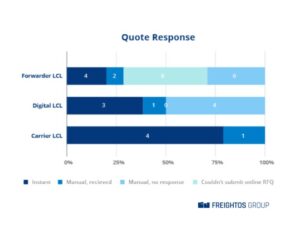
9. Identifies sales analytics to improve customer acceptance rates, sales activity, reaching carrier allocation commitments, and more
RMSs can provide business intelligence on what’s selling, and make real-time automated sell rate adjustments, all through a user-friendly interface. Forwarders receive actionable insights on:
- The number and percentage of quotes generated
- Quote turnaround times
- Contract upload and update speeds
- Lead conversion rate & user adoption rate
- Win / Loss rates
Forwarders can analyze this data to predict trends and make informed, data-backed decisions for their business operations.
10. Streamlines a forwarder’s operations.

Let’s Zoom Out
The goal of Rate Management Systems (surprisingly!) isn’t rate management.
The red thread between the benefits a comprehensive RMS provides, is that they’re ultimately all designed to drive a forwarder’s operational efficiency and provide a better CX. Forwarders simultaneously interact with numerous different parties in the logistics chain – such as customers, shippers, managers, transporters, etc. When the processes aren’t organized well, operational efficiency often takes the hit.
Rate management is therefore really just one part of a much broader tech stack that’s supposed to maximize efficiency and customer satisfaction across the entire logistics chain, with end-to-end digital cargo pricing, quoting and booking.
Read Part III of this series, to learn more about why going deep on digital drives value for Forwarders.
